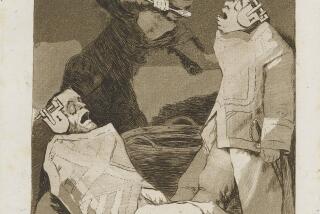SIGHTS : Collector’s Exhibit Has a Subtle but Powerful Impact : The show at the Conejo Valley Art Museum is an illuminating glimpse into the artistic process.
As you enter the Conejo Valley Art Museum these days, nothing extravagant or especially loud jumps out to grab attention and lure casual window-shoppers into the mall-bound gallery.
But, idle first impressions aside, the current show of works from Charles Craig’s collection is one of the largest and most significant exhibitions in the museum’s history.
The Santa Barbara-based Craig is a collector who specializes in the deceptively quiet niche of drawings and watercolors. The subtlety of the exhibition is mostly due to the inherent visual modesty--on the surface, at least--of the work here. But the closer you look, the richer the resonance of the art.
It may be a bit of marketing overkill to call the show a “Very Prestigious Collection of 19th and 20th Century Drawings and Watercolors”--stating the obvious only makes the visitor suspicious. But after walking through the historic sampling of art, you get the idea that this show is both a very prestigious and a very illuminating glimpse into artistic process.
The rapidity and flexibility of drawing allows the medium to serve many functions--as complete works, sketches for more complex projects, plans for 3-D works, works-in-progress and spontaneously generated images. They’re all fair game in the world frequented by Craig.
On one wall are several portraits of the patron himself, a kindly looking man. Portraits of Craig by sculptor George Rickey (a part-time Santa Barbaran) and Claire Falkenstein are quick sketches, while Larry Rivers depicts the collector with tongue firmly in cheek, framing his visage with blank checks.
From the evidence here, Craig’s collection has a generous reach, both historically and in terms of style. Contrasts abound and feed the whole. In one corner of the gallery is Camille Pissaro’s faint little figure study, while another corner hosts sculptor Robert Arneson’s “Sketch for a Monument.”
On a far wall hang a series of small, primary-colored watercolors by Herbert Bayer, the Bauhaus-connected artist who spent his later years living in Santa Barbara. His public sculpture “Chromatic Gates” can be seen on Cabrillo Boulevard in Santa Barbara.
Some of the most interesting works shed light on well-known artists out of the element for which they are best known.
Philip Guston is represented by “Punchinello Drawing,” a surprisingly traditional illustration of rueful court jesters, done in 1933 at the tender age of 20. But we can make a logical leap, connecting this piece with the mirth of his quasi-figurative work.
Several Mark Tobey pieces are on hand, including those from his typical abstract Expressionist approach but also, on a back wall, are two atypical figure studies.
Similarly, several drawings by abstract Expressionist Arshille Gorky are based on simple, elemental lines and often depict commonplace household objects. The imagery suggests both his own biomorphic paintings and the canny hermetic representations of Roy Lichtenstein. Go figure.
Strong impressions are also made by a few of the lesser-known artists in the show. The Swiss artist Hans Burkhardt’s “Study of Men,” an angular tangle of lines and limbs, is an arresting Cubist-like image from 1940. Frederico Castellan represents surrealism of the Daliesque school, all melting flesh and fool-the-eye perspective games.
Notable names--not always artistic ones--leap out of the mix: Louise Nevelson, Henry Miller, Suzan Duchamp and Sam Francis.
Throughout this show, a spirit of cultural ephemera flows like a gentle breeze. The crinkled and yellowing paper and the fading lines attest to the imprint of time on these pieces, not all of which were conceived as fodder for museum walls. But here they are for all to see.
MIXING & MISMATCHING
Experimental musician and image-maker Ted Killian, a former Venturan who now resides in Santa Barbara, is back in town for the moment via his “Fractured Visions,” a show of collages in the window of Jaffe’s Camera Center on Main Street.
Collage is a relative term here. Killian’s fracturing process involves both computer scanning and photographic treatments. Rather than the literal, physical cut-and-paste collage tradition, his tack is to pile up images in ways that are once or twice removed from reality.
Killian’s vision is blessed with a disarming naivete. A longing for pre-cynical mass culture seems to the recurring theme in his image bank, with its floating snippets of white bread, an exuberant open-mouthed boy, vintage Coke bottles, historical figures and archival advertising logos.
One gets the impression of an artist with a palette of personalized computer clip art, running benevolently amok.
Josef Woodard is an avowed cultural omnivore who covers art and music.
Details
* EAST Charles Craig’s “Very Prestigious Collection of 19th and 20th Century Drawings and Watercolors,” through Dec. 5 at the Conejo Valley Art Museum, 193-A N. Moorpark Road (in the Janss Mall), in Thousand Oaks. For more information, call 373-0054.
* WEST: Ted Killian’s “Fractured Visions,” through Nov. 22 at Jaffe’s Camera Center, 2640 E. Main St. in Ventura. For more information, call 643-2231.
More to Read
The biggest entertainment stories
Get our big stories about Hollywood, film, television, music, arts, culture and more right in your inbox as soon as they publish.
You may occasionally receive promotional content from the Los Angeles Times.










